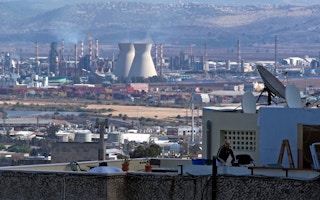I’m not a numbers person—and if you’d asked me a few months back what the Kaya Identity was, I wouldn’t have had a clue. Pushed, I might have asked whether it was a fourth film in Matt Damon’s The Bourne Identity series? Duh!
Anyone foolish enough to ask that question in a room of climate scientists would see some rolling their eyes, others shrugging in frustration. Someone might scan the walls for a blackboard, or blank space, and scribble the following formula:

Then, tossing the chalk aside and wiping the dust from their hands, they would start their explanation with a challenging question: “Does ‘I = P x A x T’ mean anything to you?”
Well, of course! But, full disclosure, I have only managed to memorize three or four equations in my life, including the formula for the photosynthetic production of sugars and Einstein’s gloriously memorable E=mc2.
Still, I used the I = PAT formula in the deep past to signal to business audiences that I could do numbers, too. Sometimes it worked, but often business people—or those tackling business-in-society issues—turned out to be as almost as blind to equations as I was.
“Enough,” insists the interrogator. ‘Define the terms for me!” Well, I say, trying to keep the truculent note out of my voice, the ‘I’ stands for the total impact of a population on the environment. The ‘P’ denotes the size of the population. The ‘A’ captures the prevailing levels of affluence (and implied resource take and environmental footprints). And the ‘T’ refers to the technologies used to achieve all of this. Am I right?
“Surprisingly, yes,” comes the reply. “Now, listen! It looks more complicated, but the Kaya Identity formula is simply a more concrete form of the I = PAT equation. Here ‘Impact’ is defined as carbon emissions, while ‘Technology’ is split into energy use per unit of GDP and carbon emissions per unit of energy consumed. Let me write it on the board for you:
F is global CO2 emissions from human sources
P is global population
G is world GDP
E is global energy consumption
“True, FPGE is not the most memorable of acronyms, but you’ll be hearing a lot more about the Kaya Identity!” As it happens, that’s also the message in Carbon Tracker’s new report, Lost in Transition, sub-titled How the energy sector is missing potential demand destruction.
This argues that rapid advances in technology, increasingly cheap renewable energy, slower economic growth and lower than expected population growth could all undermine fossil fuel demand significantly by 2040. Based on their own Kaya Identity calculations, Carbon Tracker challenge nine business-as-usual (BAU) assumptions adopted by energy companies when concluding that fossil use will grow for decades.
Typical industry scenarios see coal, oil and gas use growing by 30 per cent-50 per cent, and still making up 75 per cent of the energy supply mix in 2040. By contrast, Carbon Tracker warn that we will see major drops in fossil fuel demand as key parts of the global economy steer onto decarbonisation pathways.
Carbon Tracker senior analyst Luke Sussams concludes that, “The incumbents are taking the easy way out by exclusively looking at incremental changes to the energy mix which they can adapt to slowly. The real threat lies in the potential for low-carbon technologies to combine and transform society’s relationship with energy.”
Among industry assumptions challenged by Carbon Tracker are the following:
- Global population growth may not rise to 9 billion by 2040, the UN’s 2015 median-variant forecast applied by all fossil fuel companies.
- GDP growth could be lower than expected in key markets, including China and the U.S. The OECD sees global GDP grow at 3.1 per cent to 2040 rather than the 3.4 per cent assumed by the IEA—a key industry reference point.
- Fossil fuel industry assumptions about future carbon intensity are inconsistent with decarbonisation plans set out by some 150 countries in their Intended Nationally Determined Contributions (INDCs), filed ahead of the COP21 summit.
History suggests that few things in human affairs run in straight lines for long. And some CEOs now see that writing on the wall. A few weeks back, I was in Rome with the Global Reporting Initiative at an event co-hosted by the power company Enel. We listened to Enel CEO Francesco Scarace explaining why the energy landscape is shifting, seismically.
“
Future success will involve not just hitting targets that no-one else can hit, as Schopenhauer put it, but hitting targets that no-one else can see.
Having seen how unexpected market shifts have eviscerated companies like RWE and E-ON, Enel is determined to escape the deadly undertow of accelerating decarbonisation. Strikingly, it has teamed up with Greenpeace to explore future-fit business models. I was on a panel with Greenpeace Italy’s executive director, Giuseppe Onufrio. His take: “By completing a full transition to clean energy Enel could become the first truly green energy giant.”
Engineers may seek new equations to guide them, but as Enel’s Starace is demonstrating, future success will involve not just hitting targets that no-one else can hit, as Schopenhauer put it, but hitting targets that no-one else can see.
Fossil fuel companies still expect oil demand to grow between 0.4 per cent and 0.8 per cent a year to 2040, in large part due to the road transport sector, oil’s biggest market. But regulationsforcing greater efficiency in combustion engines could seriously dent oil demand. Longer term, oil industry scenarios forecast negligible take-up of EVs by 2040, but alternative forecasts see them becoming cost-competitive by 2025.
Carbon Tracker and Enel agree that tomorrow’s energy sector is no longer simply an incremental, block-by-block engineering play. Instead, it is also, increasingly, an exponential technology play. New forms of Gordon Moore’s Law will help drive unimaginable transformations. Sooner than we might expect, the Kaya Identity could prove to have even more dramatic endings than anything Matt Damon could come up with.
John Elkington is co-founder and Executive Chairman of Volans.


















